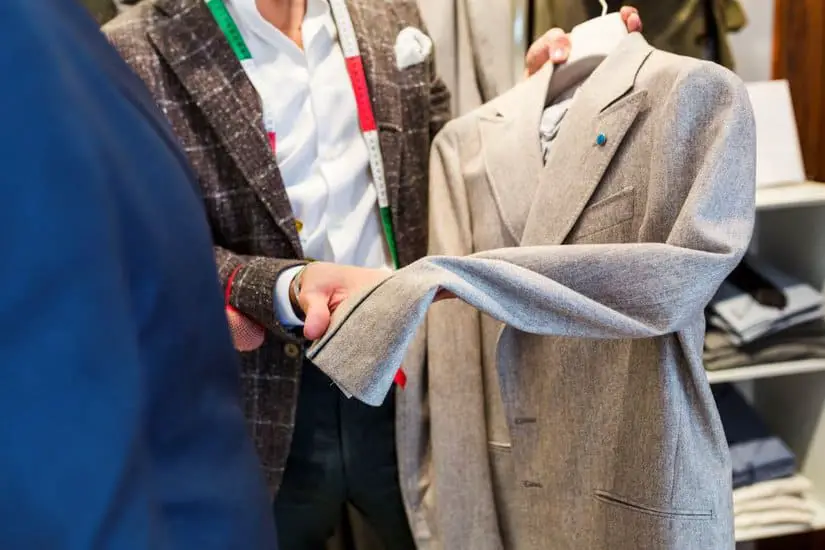When selecting the perfect blazer, one of the most crucial decisions to make is choosing the right fabric, as it dictates not only the garment’s aesthetic appeal but also its comfort and durability. The ideal fabric for a blazer should align with the intended use, the climate, and personal style preferences.
Wool, for example, remains a top choice due to its breathability, ability to absorb and release moisture, and exceptional insulating properties, making it suitable for long days and varying temperatures.
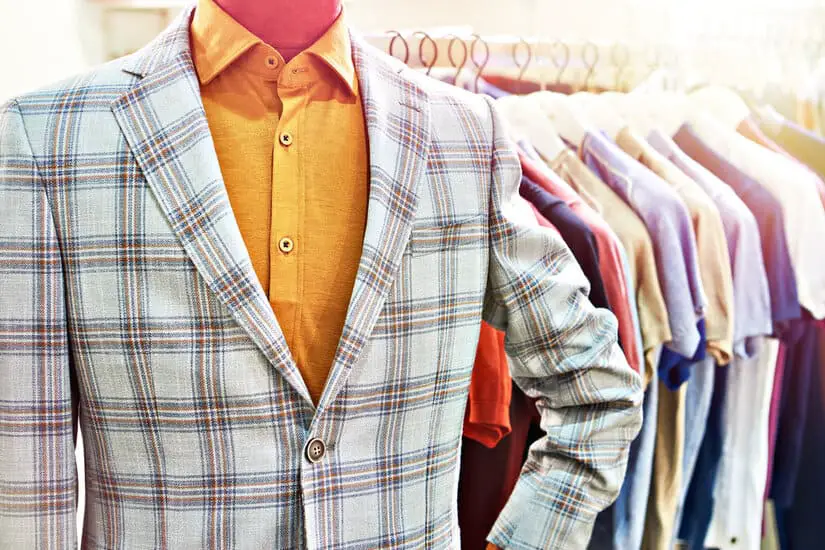
My experience with blazers extends to other fabrics like cotton, linen, and polyester blends, each offering distinct benefits. Cotton is lightweight and cool, making it ideal for casual blazers in warmer climates, while linen offers unmatched breathability and a distinctive textured appearance.
Polyester blends, on the other hand, tend to be more affordable and offer higher resistance to wrinkles and shrinkage. The selection of blazer fabric also plays a pivotal role in the overall look and feel of the blazer, with different materials offering variations in drape, texture, and weight.
Key Takeaways on Which Type of Fabric is Best for Blazers
- The right blazer fabric balances style, comfort, and durability.
- Wool is a versatile fabric choice for different environments and occasions.
- Consideration of climate, occasion, and personal style is essential in fabric selection.
You also shouldn’t miss these other top picks on this category:
Understanding Blazer Fabrics
In choosing the right fabric for a blazer, it’s crucial to consider the material’s texture, weight, breathability, and durability. Each type of fabric offers unique benefits that cater to different styles, occasions, and climates.
1. Wool and Its Varieties
Wool is a stalwart in blazer fabrics due to its versatility and excellent insulation properties. Tweed and flannel are two wool varieties that provide texture and warmth, making them ideal for cooler climates. Wool naturally resists wrinkles and maintains its shape over time. For a refined look, worsted wool is a popular choice, known for its smooth finish and suitability for all-season wear.
2. Cotton’s Comfort and Versatility
As a natural fiber, cotton is known for its softness and comfort. It’s a breathable fabric that works well for casual blazers, especially in warmer weather. Cotton blazers are less formal than wool but offer a relaxed elegance that’s perfect for smart-casual occasions. However, they may wrinkle more easily than other materials.
3. Linen for Lightweight Elegance
Linen blazers are synonymous with lightweight sophistication. This natural fiber is highly breathable, making it an excellent option for summer or tropical environments. While linen carries a distinct, intentional crease, it adds to the elegance and relaxed vibe suitable for less formal settings.
4. Silk and Blends for a Touch of Luxury
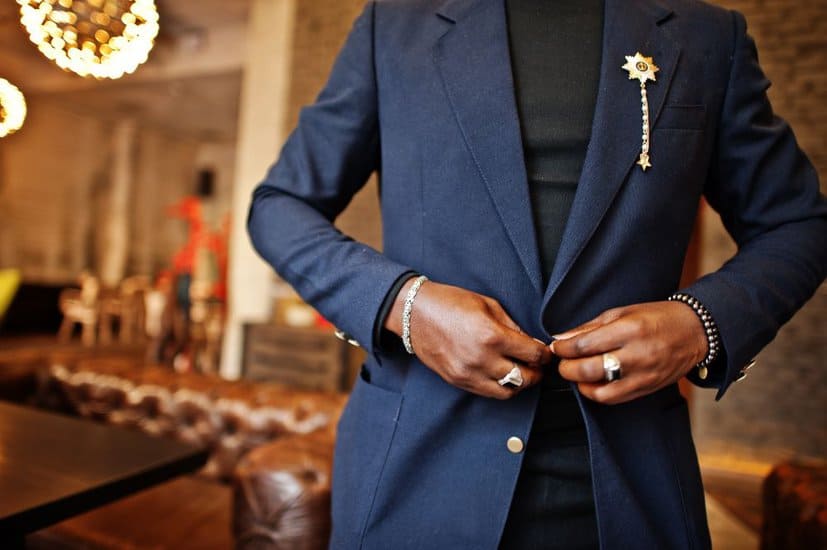
Silk blazers exude luxury with their subtle sheen and smooth texture. Often, silk is blended with other fibers, like wool-silk blends, to enhance durability while maintaining a luxurious feel. These blends also offer improved wrinkle resistance, combining the best of both worlds.
5. Synthetics: Polyester, Rayon, and Viscose
Synthetic fibers like polyester, rayon, and viscose are often used to create performance fabrics. These materials are less prone to wrinkling and can be more affordable than natural fibers. Most importantly, they often grant blazers high durability and ease of maintenance. Poly blends combine synthetic fibers with natural ones to leverage the benefits of both, such as combining breathability with wrinkle resistance.
Features of Quality Blazer Construction
A well-constructed blazer not only looks and feels great but also stands the test of time. Key elements such as the lining, fabric weight, and tailoring are cornerstones of quality craftsmanship.
The Role of Lining
The lining in a blazer is not just for comfort or aesthetics; it’s crucial for the structure and durability. A lined blazer helps the garment to slide on easily, shapes the fit, and preserves the outer fabric. High-quality blazers typically have a viscose or silk lining, which allows the blazer to breathe and maintain its form.
Importance of Fabric Weight
The fabric weight is a pivotal factor in blazer construction that affects drape and suitability for different seasons. Wool blazers are often favored for their insulating properties and ability to regulate temperature due to the natural air pockets within the weave. A heavy-weight wool is ideal for cooler climates, whereas lighter materials like cotton or linen are best for warmer weather.
Tailoring and Fit
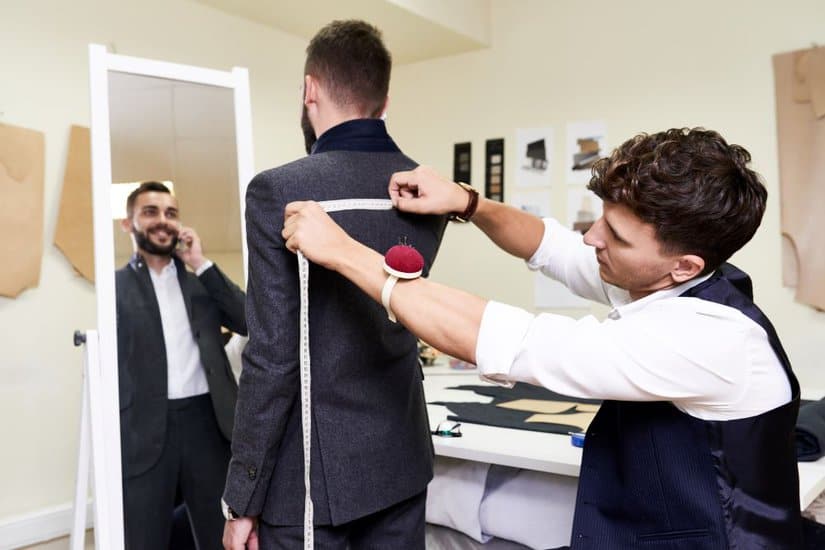
Impeccable tailoring ensures that the blazer contours to the body without restricting movement. Attention to detail in the stitching and the way the shoulders are structured contribute significantly to the overall fit.
A well-tailored jacket should have smooth lines and a shape that complements the wearer’s form. Whether it’s a standard fit or a custom one, the tailoring should allow for a full range of motion while maintaining a sleek silhouette.
Style and Design Elements
The right fabric choice can elevate a blazer’s design, marrying tradition with innovative features. From classic patterns to modern cuts, the fabric plays a pivotal role in a blazer’s overall appeal.
Traditional Patterns and Solids
When selecting blazer fabrics, I consider traditional patterns like plaid, checks, and tweed, which exude timeless elegance. These fabrics are not only stylish but also functional, offering warmth and durability. Solids in classic hues like navy or grey provide a versatile base for both casual and formal looks, making them an essential in any wardrobe.
Innovative Design Features
The fabric’s weave and weight directly impact design options such as lapels and flap pockets. For example, velvet, a fabric often chosen for its luxurious texture, is perfect for a shawl lapel, which adds a touch of formal sophistication. Tweed and flannel, heavier and more textured, offer a rustic charm and can accommodate details like notch lapels and patch pockets for a country-inspired aesthetic.
Decoding Jacket Vents and Sleeve Buttons
The fabric’s drape and structure inform the placement and functionality of vents and buttons. A single vent, often seen in classic styles, works well with stiffer fabrics, while double vents afford more ease, ideal for lighter and more flexible materials. Regarding sleeves, I ensure fabric compatibility with functional sleeve buttons, which add a bespoke feel and allow for adjustments in sleeve length.
Durability and Maintenance
When I select a fabric for my blazer, not only do I think about how it looks and feels, but also how it holds up over time and what kind of maintenance it requires. My goal is to find materials that offer a balance between durability and ease of care, which translates to lasting performance with minimal fuss.
Care Instructions and Longevity
Every blazer in my closet comes with its own set of care instructions that are crucial for ensuring its longevity. For instance, wool, a highly durable fabric known for its insulation and natural crease-resistance, often requires dry cleaning to maintain its structure and appearance. On the other hand, synthetic blends can be more machine washable and easy care, but they might not match wool’s resilience over time.
- Wool Blazer: Dry clean only to retain shape and texture.
- Synthetic Blend Blazer: Machine wash on a gentle cycle is often acceptable.
Factors Influencing Durability

The durability of blazer fabrics depends on several factors. A tightly woven wool blazer will not only resist lint and wear but also display excellent crease-resistant properties. Synthetic fibers, praised for being easy care, may have added treatments to enhance their resistance to creasing and soiling.
- Fiber Content: Natural fibers like wool typically offer better durability but may need special care.
- Weave Density: Tightly woven materials tend to be stronger and protect against everyday wear.
Styling Your Blazer
When choosing a blazer, consider the occasion and the statement you want to make. The fabric and fit are crucial in determining whether the blazer is more casual or formal, and accessorizing appropriately can transform a look entirely.
1. Casual vs. Formal Blazers
The fabric choice significantly affects whether a blazer feels casual or formal. For a casual look, opt for a blazer with a soft shoulder and more relaxed textures like corduroy or unstructured wool.
In contrast, formal blazers often have a sharper silhouette, are made of finer fabrics like cashmere or worsted wool, and display a more defined shoulder line. Business casual blazers strike a balance, offering a professional look without appearing too rigid. Paying attention to these details is essential because they dictate the blazer’s versatility and suitability for different settings.
2. Accessorizing and Making Statements

Make a statement with a blazer by how it’s accessorized. A casual blazer paired with a simple white tee, dark denim jeans, and sneakers can make for a simple, yet effective statement.
For business casual, a crisp collared shirt, chinos, and leather shoes elevate the look. Using accessories like colorful pocket squares or unique lapel pins can inject personal style into a blazer. These small touches allow for expression of individuality while remaining appropriate for the occasion.
3. Blazer Textures and When to Wear Them
Be meticulous about the texture of a blazer, as it can dictate the entire vibe of an outfit. Textures add depth and character, influencing how casual or formal the look is. Opt for a corduroy blazer for a tactile feel, perfect for a relaxed winter gathering.
During warmer seasons, linen blazers provide breathability with a visibly unique texture, ideal for outdoor events. Always consider the season and setting before deciding on a textured blazer, ensuring comfort and contextual appropriateness.
4. Fit and Sizing Tips
When exploring the perfect blazer, focus on two elements: material quality and fit. The fit is pivotal because a good fabric worn poorly can be a disservice to both the piece and the wearer.
5. Finding the Right Size
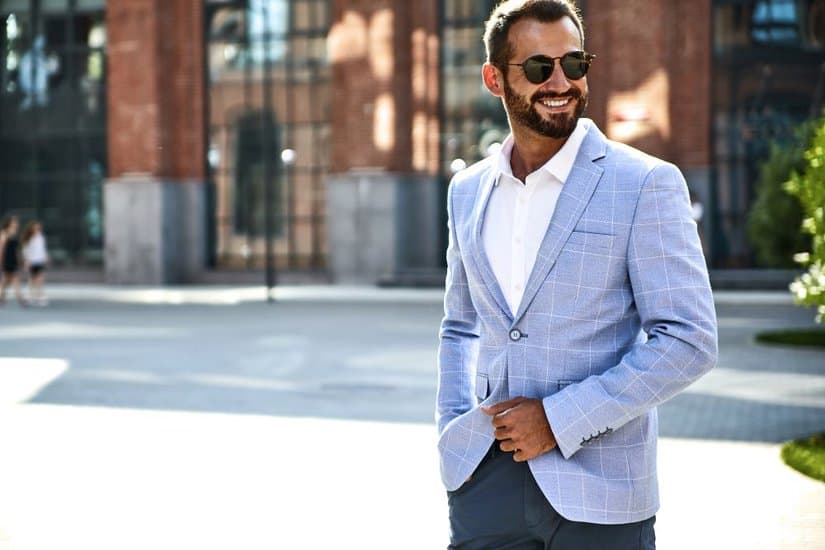
The first step to a well-fitted blazer is understanding your chest size. Blazer sizes correspond to chest measurements; they typically range from size 34 to 52 inches. For instance, if your chest measures 40 inches around, a size 40 blazer should be a good starting point.
Use a blazer sizing chart and pay attention to brand-specific variations. Do not just pick up your usual size without checking the brand’s specific sizing guide. Additionally, aim for about 2 to 3 inches of space in the chest area for a comfortable fit without the jacket looking baggy.
6. Adjusting for Different Body Types
Each body type requires adjusted fittings, as universal fit doesn’t cater to everyone. For example, slim fit blazers may be flattering for a lean physique but can restrict movement or look too tight on someone with a broader build. When adjusting for different body types, tailoring is key. If a blazer fits well around the chest and shoulders but is loose around the waist, it can typically be taken in.
Allow some room for layering—a blazer that’s too snug when wearing a shirt underneath defeats the purpose. The materials also play a role in fit; natural fabrics like wool can sometimes offer a bit more give, while synthetic materials might not conform as well. Keep these points in mind when choosing a blazer to ensure it enhances your body type.
The Best Fabric Choices for Various Occasions
Selecting the right fabric for a blazer is crucial because it dictates the comfort, versatility, and appropriateness for various settings.
Work and Business Events
For a classic blazer that fits well within a business casual environment, I recommend wool. It offers warmth, breathability, and tends to have a soft shoulder for a professional look. When considering a more affordable option that still looks sharp for work, a polyester blend can mimic wool’s appearance without the higher cost. If the event calls for extended wear, such as a conference, opt for a blazer with performance fabric that includes four-way stretch, allowing for greater mobility and comfort.
Casual Outings and Travel
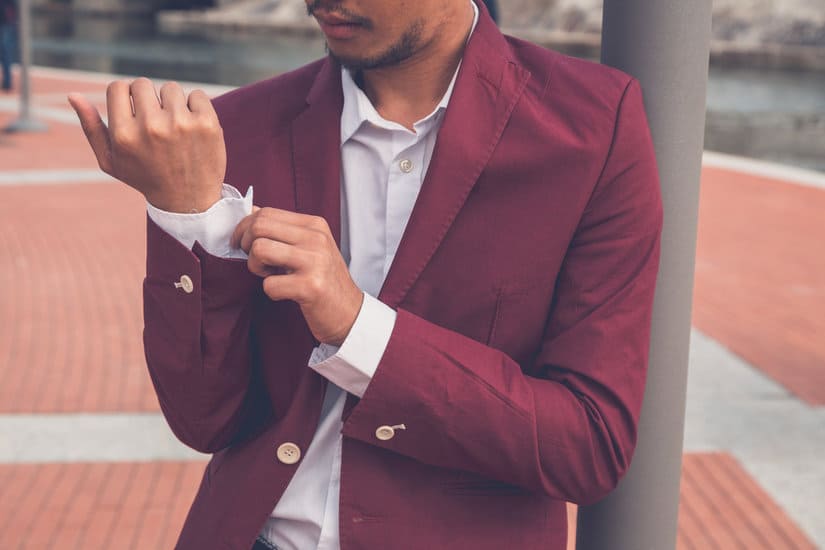
A casual blazer made of a durable cotton or linen is an excellent choice for leisure activities or travel; they’re breathable and offer a more relaxed fit. Denim blazers also provide a sense of ease and can transition smoothly from a daytime exploration to an evening dinner. For those looking for an affordable blazer that does not sacrifice style, cotton blends offer a good balance between cost and aesthetic.
Special Occasions and Seasonal Variations
During special occasions, such as weddings or formal parties, materials like silk or velvet add a touch of elegance. A winter blazer should be made of a heavier wool or a wool-cashmere blend to keep warm.
Meanwhile, sport coats are suitable for less formal events and come in a multitude of fabrics, each giving a different level of warmth and texture to match the season. Fabrics with a subtle sheen or unique patterns can elevate your presence at any exclusive event.
Frequently Asked Questions
In this section, I address some of the common inquiries you might have regarding the best types of fabrics for blazers, whether it’s for durability, professional settings, weather appropriateness, or general quality.
What are the most durable materials for a men’s blazer?
For men’s blazers, durability often comes from woolen fabrics. When tightly woven, wool creates air pockets that not only provide insulation but also enhance the fabric’s ability to absorb and release moisture, contributing to the longevity of the blazer. Learn more about the woolen fabric for blazers.
What type of fabric is ideal for a women’s blazer for professional settings?
A women’s blazer for professional settings benefits greatly from structured and refined materials. Wool, particularly in a worsted weave, offers a sleek look while preserving the garment’s shape. Adding a lining such as silk or rayon also increases the durability and comfort of the blazer. Explore the advantages of lining a blazer.
How do blazer fabrics differ from suit fabrics in terms of composition and use?
Blazer fabrics tend to have more variety and can afford bolder textures and colors compared to suit fabrics, which are usually more uniform for a complete set. Blazers also allow for fabric blending like wool-silk or cotton-linen, offering unique textures and characteristics suited for standalone pieces. Understand the qualities of blended fabrics for blazers.
What is the preferred blazer material for hot weather or summer wear?
In hot weather or summer, the preferred blazer materials are lightweight and breathable fabrics such as linen and cotton. These fabrics help to keep the wearer cool while still maintaining a structured and professional appearance.
Which fabrics are typically used in high-quality blazers?
High-quality blazers are usually made from natural fibers like wool, cashmere, or cotton. These materials are favored for their texture, breathability, and ability to hold shape over time. The craftsmanship in the weaving and finishing also contributes to the luxury feel of the blazer. Assess the quality of fabric for better understanding.
How does fabric choice affect the overall quality of a blazer?
The choice of fabric affects a blazer’s overall quality by determining its appearance, feel, durability, and ease of care. A superior quality fabric will ensure that the blazer maintains its form, offers comfort to the wearer, and can withstand regular wear and cleaning without losing its integrity.

Samoel Ovanessian is the founder and creator of StylishAlpha.com – a website dedicated to men’s fashion. As a proud owner of more than 200 ties, he loves digging through new clothing combinations for everyday use, formal events and even just for fun. You can read more about Samoel here.

